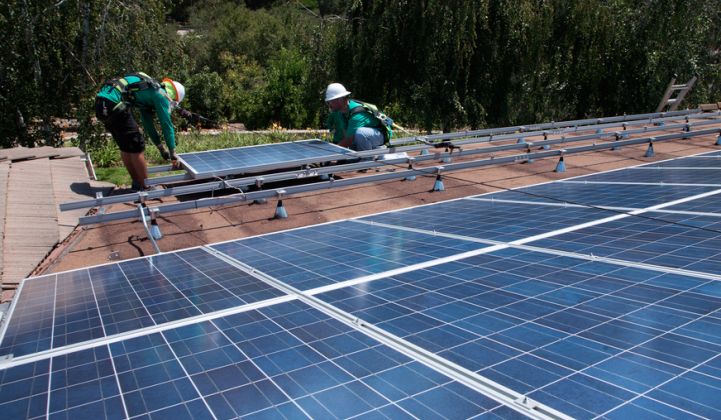The coming year is likely to be a transitional one for net metering. Last October, the Hawaii Public Utilities Commission decided to phase out its net energy metering program. In December, Nevada followed suit.
The extension of the federal Investment Tax Credit (ITC) will only turbo-charge deployment of customer-sited solar in the coming years, compelling further re-examination of existing distributed generation policies.
As more states consider moving beyond net metering, it is essential to consider the potential tax implications of successor policies.
For this reason, the Clean Coalition conducted an analysis to compare the tax impacts on a typical California homeowner with solar getting compensated under a feed-in tariff (FIT) program compared to net metering.
The Internal Revenue Service has not ruled that energy sold to a utility under a FIT is taxable gross income. However, in this analysis, the Clean Coalition analyzed the implications for the customer-generator if the IRS were to determine that the revenue from energy sales under a FIT constitute taxable gross income.
The result: if energy sales under a FIT are subject to income tax, any tax liability will be offset by the value of applicable tax deductions at a FIT rate up to approximately $0.15 per kilowatt-hour.
Details of the analysis
Under net energy metering (NEM), excess energy is exported to the grid and the customer is credited at the retail rate for each kilowatt-hour delivered. When a NEM system is not producing enough power to meet on-site load, the customer buys power from the electric utility at the retail rate. Under a FIT, a customer-generator sells all power produced to the local utility at a long-term fixed rate and continues to buy all their energy at the retail rate.
Through this analysis, we investigated the tax implications for a California customer-generator who switches to a residential FIT from a NEM program if the IRS were to determine that the FIT energy sales constitute taxable gross income. To do this, we modeled the following:
- Electricity consumption and PV generation for a typical California customer
- Federal and state tax treatments
- Rate structures for the customer, including the complete compression of California rates from four tiers to two tiers in 2019
The analysis examined impacts on an average Pacific Gas & Electric (PG&E) residential customer located in San Jose, California. We used this location because Santa Clara County, home to the city of San Jose, boasts one of the highest numbers of solar PV and net-metered residential customers in the state -- and the most in PG&E’s service territory.
For this analysis, we assumed the customer-generator owned a 5-kilowatt solar PV system with an annual output of 7,500 kilowatt-hours per year.
We factored in standard federal and California state tax liability, as well as the applicable tax benefits related to either the NEM or FIT program analyzed.
Results
If energy sales under a FIT are subject to income tax, any tax liability will be offset by the value of applicable tax deductions at a FIT rate up to approximately $0.15 per kilowatt-hour for the typical customer, as detailed below.
The extent to which depreciation of a distributed generation (DG) system offsets taxes on energy sales depends on two key variables.
First is the amount of system costs eligible for deduction. If the costs of installing and maintaining the DG system are reduced, then the value of income deductions is lower and vice versa.
The second key variable is the FIT rate. When a lower price is paid for energy, the amount of taxable income is reduced and vice versa.
The National Renewable Energy Laboratory’s System Advisory Model, which we utilized for this investigation, only allowed for analysis of net-metered and buy-all/sell-all FIT systems. However, a middle ground exists and was recently implemented in Hawaii.
Under this hybrid self-supply plus FIT approach, known in Hawaii as the “grid-supply” option, generation from a customer’s system is first used to satisfy simultaneous on-site load, enabling the customer to avoid purchasing energy at the retail rate from the utility. The customer captures the full value of avoided energy purchases, which may currently be higher than the FIT rate or may become higher over time. Any energy not consumed on-site at the time of generation is sold to the utility at an established FIT rate. The customer continues to buy energy from the utility at the retail rate to meet load not served by the DG system.
Under this hybrid self-supply plus FIT approach, the net present value (NPV) and the payback period would be about halfway between the corresponding FIT and NEM systems. A self-supply plus FIT approach, where the customer sells 50 percent of energy produced, would yield a NPV of approximately $7,829 and a payback period of roughly 7.1 years.
In practice, the results would tend toward the NEM example if daytime load coincided with generation, or toward the FIT example if on-site load did not coincide with generation. Solar panels installed in a more westerly orientation typically support greater matching of generation and load.
Over the coming years, declining costs of solar PV and changes in applicable rate design, such as the compression of California rates from four tiers to two tiers, will influence the results. We explored potential consequences of these changes by modeling two scenarios: 2015 and 2019. See the full analysis for additional details
***
John Bernhardt is outreach and communications director at the Clean Coalition. This piece was originally published by the Clean Coalition and is reprinted with permission.





